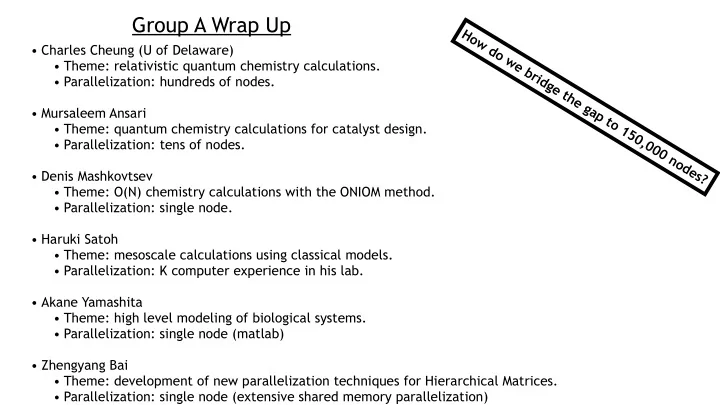

Group A Wrap Up How do we bridge the gap to 150,000 nodes? • Charles Cheung (U of Delaware) • Theme: relativistic quantum chemistry calculations. • Parallelization: hundreds of nodes. • Mursaleem Ansari • Theme: quantum chemistry calculations for catalyst design. • Parallelization: tens of nodes. • Denis Mashkovtsev • Theme: O(N) chemistry calculations with the ONIOM method. • Parallelization: single node. • Haruki Satoh • Theme: mesoscale calculations using classical models. • Parallelization: K computer experience in his lab. • Akane Yamashita • Theme: high level modeling of biological systems. • Parallelization: single node (matlab) • Zhengyang Bai • Theme: development of new parallelization techniques for Hierarchical Matrices. • Parallelization: single node (extensive shared memory parallelization)
Development of next-generation relativistic atomic code for high precision calculations of properties of atoms and ions C. Cheung, M. S. Safronova, S. G. Porsev, M. G. Kozlov, I. I. Tupitsyn Current project: development of Applications precision calculation methods for open-shell atom and ion properties GPS Use theory to propose and design new experiments • Which atom or ion should be used for said experiment? • Need to know properties of atoms and ions to high • precision for many applications! Need to know uncertainty of the theory values. • Method Beyond the New Technologies Standard Model valence 1s 2 ...6p 6 6d 2 7s 2 Astrophysics and Cosmology electrons core Problem 1: core-core and core-valence correlations (MBP Quantum Information Problem 2: valence-valence correlations (CI+PT)
Mursaleem Ansari Design a new catalyst for C-H bond activation of CH 4 In biological system, methane is converted to methanol by the action of P450 enzyme RH + O 2 + NADPH + H + → ROH + H 2 O + NADP + O O N N Fe(IV) N N M n+ N 110.8 kJ/mol N N 81.6 kJ/mol Fe(IV) Fe=O = 1.62–1.66 Å How to enhance catalytic activity ? N N (1) Axial ligand effect (2) Changing O O donor atoms of ligand (3) Changing ligand coordination sphere > 1.62–1.66 Å (4) Changing geometries (5) Effect of Lewis acid (6) Stabilized Cl [(TPP)( m -CBA)Fe( IV ) high spin state (d 4 configuration) (µ-N)Fe( IV )(O)(TPP .+ )] - (7) Changing oxidation state (8) Exchange C-H activation (CH 4 ) enhance reactivity (EER) Nam, W. et al. J. Am. Chem. Soc. 2012, 134 , 11112.; Montellano, P. R. et al. Chem. Rev. 2010, 110 , 932.
ONIOM approach in an optimization of structures of polymers via elongation D. Mashkovtsev Elongation : fragmentation quantum chemical method for polymers. wavefunction, Simulation is polymerization like i.e. electronic process. structure ONIOM Frozen QM MM optimized geometry elongation direction Computational complexity → O( N ) with polymers growing size of system
Recommend
More recommend